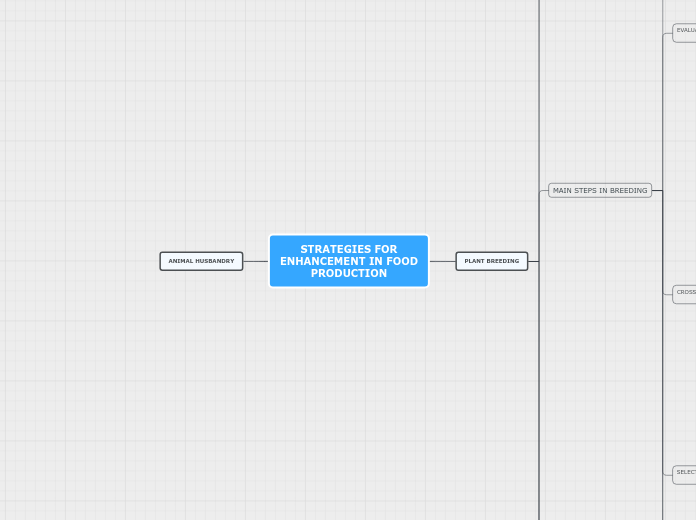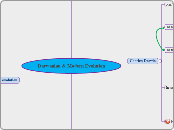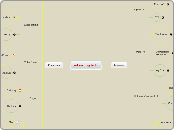STRATEGIES FOR
ENHANCEMENT IN FOOD
PRODUCTION
ANIMAL HUSBANDRY
PLANT BREEDING
PLANT BREEDING FOR DISEASE
RESISTANCE
Subtopic
DISEASES
Viruses: tobacco mosaic
Bacteria : black rot of crucifers
Fungi: brown rust of wheat , late blight of poatato
HIGH YEILDING (HYVs)
Millets: Hybrid Bajra (PHB,BJ,BK) and
Jowar (CSH series)
Sugaecane: Saccharum officinarum
Maize: Protina
Rice: Jaya, Ratna
Wheat: Kalyan Sona,Sharbati Sonara
EXTRA TERMS:
HETEROSIS/HYBRID VIGOUR
when such hybrids are produced,they are
better than parents and continue to be
cultivated
better yeilding varieties in plants in terms
of growth,size,climatic condition
INBREEDING DEPRESSION
reduced biological fitness in a given
population because of interbreeding
among related indiviuals
genetically similar plants produce
reccessive traits in their progeny
MAIN STEPS IN BREEDING
MULTIPLICATION OF IMPROVED SEEDS
Seeds are certified and packed in sealed
packects as certified seeds. Each sealed
packet caonatins information:
validity of certificate
special features (if any)
absence of weeds and presnce of inert
matter (not more than 1%)
purity of seeds (99%)
date of test
National Seeds Corporation
(NSC)streamlines raising seeds of
improved varieties
high rate of germination
high order of purity
free of pathogens and pests
free of weed seeds
TESTING RELEASE AND COMMERCIALISATION
SELECTION AND TESTING OF SUPERIOR
RECOMBINANTS
STEPS:
iii) Crossing the selected inbred lines to
produce uniform F1 population with
desired qualities and then F1 seeds can be
directly grown
ii) Selfing the selected plants through
several generations to produce uniform
homozygous inbred lines
i) Selection of haploid plants that have the
combination of desired characters
CROSS HYBRIDIZATION BETWEEN
SELECTED PARENTS
TYPES
Intergeneric: different genera
Interspecific: different species
Intervarietal: different lines or varieties of
the same species
Intravarietal: same variety
STEPS
step 2: Not all hybrids show the desired
characters. only, one in a few 100 to 1000
crosses show the desirable combination.
such hybrid plants are sleceted
step 1: pollen grains from the desirable
plant chosen as male parent are collected
and placed on stigma of flowers of female
parents
PROCEDURE
pollination or crossing
tagging
bagging
emasculation (stamens removed at bud
stage)
Selection and Isolation ofmplants
EVALUATION AND SELECTION OF
PARENTS
The germplasm is evaluated and
plants with desired combinations of
characters are identified. selection is
carried out for plants with
advantageous charaters based on
phenotypic characters
Clonal Selection
new genetic variability cannot be
introduced
helps in conserving hybrid vigour and
quality of crop
plants that multiply by vegetative
propogation
Pure Line Selection
process repeated continously to obtain
pure line
sown in separate rows
plants selected on basis of best agronomic
characters
self pollinated crops
Mass Selection
the process is repeated many times to
obtain homozygosity
plants selected for desired features and
their seeds are collected
grown in same field
cross polinated plants
GERMPLASM COLLECTION FOR
VARIABILITY
Types of Seeds
Cyropreserved (-196° C)
Recalcitrant Seeds (aerobic humid
conditions)
Orthodox Seeds (-10° to -20° C)
Centres for plant genetic resources
International
International Board of Plant Genetic
Resources (IBPGR)
indian
Central Rice Research Institute(CRRI)
International Crops Research Institute for
Semi-Arid Tropics (ICRISAT
The sum total of all alleles of the genes
present in the existing and past varieties of
a crop and its wild relatives constitutes the
germplasm
wild species related to the crop species
pur lines produced by plant breeders
old local or desi varieties
improved varities that are no mor in
cultivation
all cultivated improved varieties
OBJECTIVES
better adaptability
better quality
abiotic resistance
eary maturity
resistance to diseases and pests
high yeild
DEFINATION
plant breeding is a technique of genotypic
improvement of economically important
crop plants to produce new crops that are
better suited for cultivation,give better
yeild and are disease resistant









